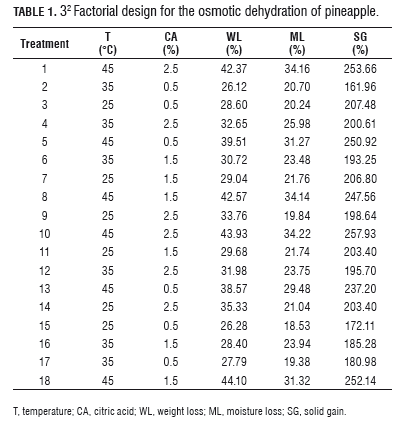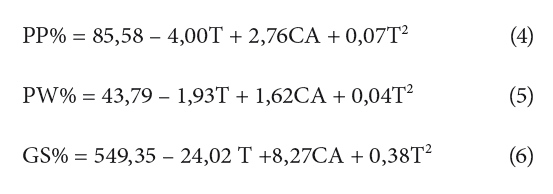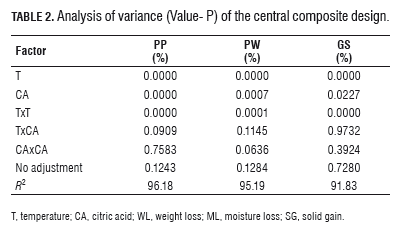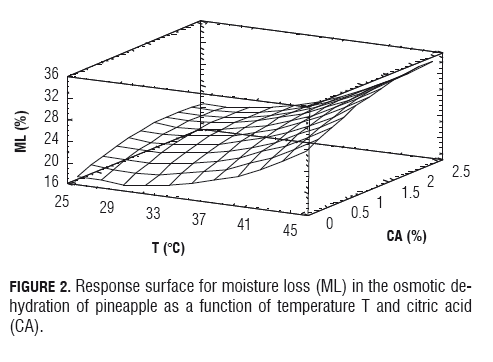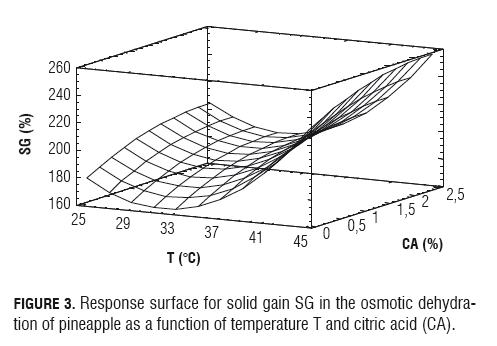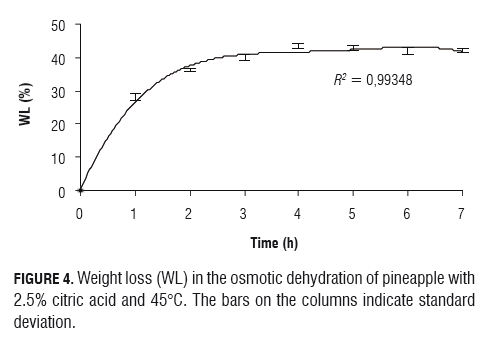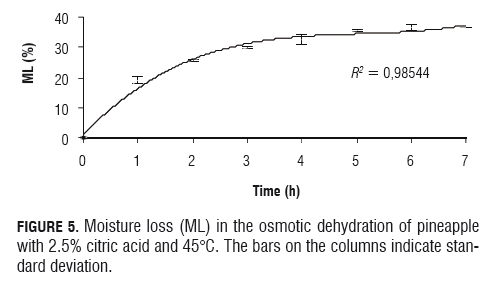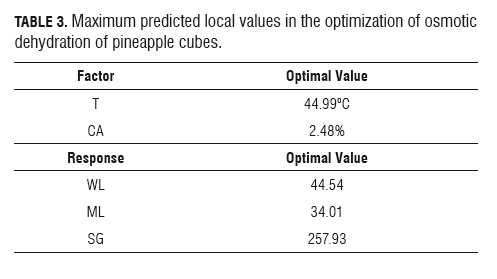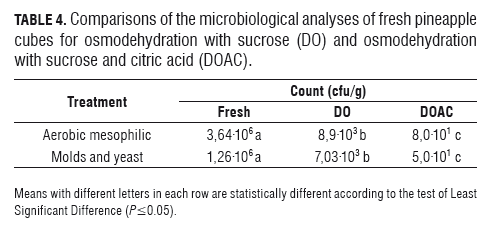Services on Demand
Journal
Article
Indicators
-
 Cited by SciELO
Cited by SciELO -
 Access statistics
Access statistics
Related links
-
 Cited by Google
Cited by Google -
 Similars in
SciELO
Similars in
SciELO -
 Similars in Google
Similars in Google
Share
Agronomía Colombiana
Print version ISSN 0120-9965
Agron. colomb. vol.29 no.2 Bogotá June/Aug. 2011
PHYSIOLOGY & POST-HARVEST TECHNOLOGY
Optimization of osmotic dehydration of pineapple (Ananas comosus L.) using the response surface methodology
Optimización de la deshidratación osmótica de piña (Ananas comosus L.) aplicando superficies de respuesta
José E. Zapata M.1, 2,Johan M. Arias A.1, and Gelmy L. Ciro G.1
1Faculty of Pharmaceutical Chemistry, Universidad de Antioquia. Medellin (Colombia).2Corresponding author. jedgar_4@yahoo.es Recceived for publication: 5 August, 2010. Accepted for publication: 2 June, 2011.
ABSTRACT
The response surface methodology was used to optimize the effects of temperature (25 - 45°C) and citric acid concentration (0.5 - 2.5% w/w) in osmotic dehydration of pineapple in a sucrose solution. A 32 factorial design was used with weight loss (WL, %), moisture loss (ML, %) and solid gain (SG, %) as responses. The models obtained for all the responses were significant (P=0.05) without a significant lack of fit. The results suggest that WL, ML and SG can reach 42.62%, 36.54% and 292.16% respectively, after 4 to 6 h of the process, with 100% sensory acceptance and reductions in microbial counts of more than two log cycles, using the conditions defined by the optimization (44.99°C and 2.48% citric acid).
Key words: citric acid, osmotic drying, post harvest, fruit.
RESUMEN
Se aplica la metodología de superficies de respuesta para optimizar el efecto de la temperatura (25 - 45°C) y la concentración de ácido cítrico (0,5 - 2,5% p/p) en la deshidratación osmótica de piña en soluciones de sacarosa. Se utiliza un diseño factorial 32 con pérdida de peso (PP, %), pérdida de humedad (PW, %) y ganancia de sólidos (GS, %) como respuestas. Los modelos obtenidos para todas las respuestas son significativos (P=0,05) sin carencia de ajuste significativa. Los resultados sugieren que se puede alcanzar 42,62%; 36,54% y 292,16%, para PP, PW y GS, respectivamente, después de 4 - 6 h de proceso, con aceptación sensorial del 100% y reducciones en los recuentos microbianos de más de dos ciclos logarítmicos, utilizando las condiciones definidas en la optimización (44,99°C y 2,48% de ácido cítrico).
Palabras clave: ácido cítrico, secado osmótico, poscosecha, frutales.
Introduction
The pineapple (Ananas comosus L.) is consumed as fresh fruit, sliced or dried (Saxena et al., 2009), worldwide. Due to its short shelf life (4 - 6 d) (Hajare et al., 2006), multiple strategies have been evaluated to prolong its durability (Hajare et al., 2006; Peiró-Mena et al., 2007; Fernandes et al., 2008; Chauhan et al., 2009; Saxena et al., 2009; Torri et al., 2010; Ramallo and Mascheroni, 2010). For cut products, durability is even lower (Soliva-Fortuny and Martin-Belloso, 2003), mainly due to some changes in the physicochemical and physiological characteristics (Toivonen and Brummell, 2008) resulting from increased enzymatic action due to cell damage caused by cutting (Torres et al., 2007). Post-harvest losses of fruits in general account for 20 - 25% of total fruit production in developed countries (El-Ghaouth et al., 2004; Zhu, 2006; Sharma et al., 2009) and even more in developing countries (Sharma et al., 2009).
Osmotic dehydration (DO) is a food preservation technique that relies on the reduction of water activity and humidity of the product, which has advantages over other dehydration techniques because it preserves the sensory and nutritional characteristics of foods (Ozdemir et al., 2008; Fernández et al., 2005), since it does not require high temperatures, in addition it has low investment costs which facilitates its implementation in rural areas, and is an excellent alternative for conservation of cut products. Its processes involve simultaneous water loss and solute gain (Saxena et al., 2009), in which the mass transfer depends on variables such as pressure, temperature (Corzo and Gómez, 2004), concentration of solutes (Corzo and Gómez, 2004), fruit/syrup ratio and degree of agitation, among others (Fernandes et al., 2008).
Osmodehydrated products are part of the so-called intermediate moisture products and should be consumed in a relatively short time or be subjected to conservation steps(Fernandes et al., 2008; Ramallo and Mascheroni, 2010). One area for improvement for these products is their microbial load, since it may affect the shelf life of packaged products, especially cut ones (Zapata et al., 2004; Castelló et al., 2009). For these reasons, the search for strategies to reduce the microbial load of osmodehydrated products, not including additional processing steps, could reduce postharvest losses, while maintaining costs, thus providing added value to fruits and vegetables, improving the income level of farmers, enabling them to better manage prices even at harvest and allowing the possibility of using lower quality fruit.
DO kinetics of the pineapple using sucrose syrup as a function of the solution concentration and temperature has been studied (Parjoko et al., 1996; Silveira et al., 1996; Lombard et al. 2008) and the diffusion coefficients have been determined (Ruiz-López et al., 2010). Losses of up to 30% have been reported for citric acid (CA) (Peiró-Mena et al., 2007) and ascorbic acid (Ramallo and Mascheroni, 2010) in pineapple and other fruits (Moraga et al., 2010) during DO, which can affect quality in osmodehydrated products.
It is known that suitable combinations of pH and water activity (Aw) can be very effective in controlling microorganism in food. For example, it has been found that pretreatment with acid solutions improves the inactivation of Escherichia coli in dehydrated apples (Derrickson- Tharringtona et al., 2005). Citric acid has been widely accepted as effective in reducing the surface pH of different types of cut fruit (Soliva-Fortuny and Martín-Belloso, 2003). Combinations of low pH and low Aw have been reported to promote the development of microorganisms with greater resistance (Tiganitas et al., 2009), that is, some of these combinations do not effectively inhibit problem microorganisms (Derrickson-Tharringtona et al., 2005). These results make it necessary to carefully evaluate the combination of preservation methods before suggesting an application for a process.
The response surfaces are very effective tools for optimization, which have been used in different food processes among which DO is include (Azoubel and Murr, 2003; Corzo and Gómez, 2004; Valdez-Fragoso et al., 2007; Ozdemir et al., 2008; Chauhan et al., 2009). The main advantage is that they reduce the number of experiments needed to obtain statistically valid results (Ozdemir et al., 2008) and are faster and more informative than traditional assessments which evaluate one variable at a time (Ozdemir et al., 2008).
The aim of this study was to optimize the osmotic dehydration of pineapple cubes, through the combined effect of temperature (T) and citric acid concentration (CA), using the response surface methodology to maximize weight loss (WL), moisture loss (ML) and solid gain (SG), seeking to increase solid gain (sucrose and citric acid) to neutralize acidity losses that may occur in the process and reduce the microbiological risk. Additionally, we evaluated the microbiological quality and sensory acceptance of the osmodehydrated pineapple cubes in the established optimal conditions to ensure the microbiological and sensory quality of the product.
Materials and methods
Sample preparation. Pineapples of the Manzana variety with °Brix between 9 and 11 were selected, and obtained commercially in Medellin; washed and disinfected with sodium hypochlorite at 50 mg L-1 for 10 min; peeled, cored and cut into 1 cm cubes.
Osmotic treatments. The treatments were carried out under atmospheric pressure conditions with containers at rest, using sucrose solutions of 45°Brix and citric acid concentrations between 0.5 to 2.5% (w/w). The pineapple cubes were placed in a fruit/syrup ratio of 5/1 (g/g). The samples were then subjected to a water bath with a temperature control (D-77960 Jubalo®) using temperatures between 25 - 45°C for 4 h. These conditions were defined based on literature reports (Ruiz-López et al., 2010; Lombard et al., 2008).
Analytical determinations. The moisture analysis was carried out in a forced air oven (Binder, model termolab 53®), using the AOAC oven drying method 934.06 (AOAC, 1995). The °Brix was measured with a refractometer (Milton Roy Company® LR 45227) and weight determinations with an analytical balance (Sartorius CP 2245®). Each analysis was done in triplicate.
For the calculation of weight loss (WL) and moisture loss (ML), equation 1 was used.
where: wi is weight/moisture initial and wf is weight/ moisture final. The soluble solid gain (SG) was calculated as shown in equation 2.where: °Brixf represents final Brix degrees and °Brixi represents initial Brix degrees. Statistical analysis. eighteen experiments were carried out according to a 32 factorial design with 2 replicates, using the factors temperature (T) (25, 35 and 45°C) and citric acid concentration (CA) (0.5, 1.5 and 2.5% w/w) and the response variables WL, ML, and SG. The response surface methodology assumes that there is a polynomial function that relates the responses to the independent variables in the process (factors) (Montgomery, 1991). Therefore, the experimental data obtained from the factorial design (Tab.1) were fitted to a polynomial of the form found in equation 3 (Montgomery, 1991).
Response = a0 + a1X1 + a2X2 + a12X1X2 + a11X12+ a22X22 (3)
where the response is WL, ML or SG, the ai are adjustable constants and X1, X2, are T and CA, respectively.
We developed the analysis of variance (ANOVA) with a confidence level of 95%, which includes the statistical significance of each of the terms of the adjustable model (Value - P), the estimated effects in each term (ai), the coefficient of determination of the model (R2) and the lack of fit in order to establish the accuracy of the model to represent the data. The resulting models were optimized to determine the levels of the variables that give the maximum values of the responses.
Microbiological analysis. Analysis was performed in triplicate on samples of fresh pineapple and osmodehydrated pineapple with and without citric acid. Mold yeasts and aerobic mesophilic were counted. For comparison of means, this study applied the Least Significant Difference (LSD) method with a confidence level of 95%, using the software Statgraphics Plus 5.1®.
Sensory analysis. Sensory evaluation was performed using a panel of 50 untrained judges, made up of students and staff of the Food Department of the Universidad de Antioquia. The sensory method was an acceptance test: I like - I do not like. The minimum number of responses was established for a 5% probability according to a binomial test.
Results and discussion
To define the conditions of CA and T that maximize the values of the parameters WL, SG and ML, a 32 factorial Results of the ANOVA of the central composite design are shown in Tab.2, indicating the statistical significance of each factor for each response variable (Value - P).
To adjust the final model, factors without significant effects (P>0.05) were eliminated which appear in the ANOVA (Tab.2), and the R2 and the lack of fit of the resulting model were determined. Both data are presented in Tab.2 for adjusted models of WL, ML and SG, which appear in equation 4, 5 and 6 respectively. The ai coefficients in these equations correspond to the effects of the factors in terms of their actual values. The R2 values (> 91%) and lack of fit (P=0.05) in Tab.2 suggest that these polynomials adequately represent the relationship between responses and factors.
In Figs. 1, 2 and 3 one sees that all responses have an upward trend with increasing values of the factors (T and CA).Effect on the percentage of weight loss
The weight reduction (WL) is an indirect measure of water loss in osmodehydrated products, which is important in transportation and storage for high volumes. Tab.2 demonstrates that WL was significantly affected by T (P = 0.0001) in its linear and quadratic terms. The positive and negative indications of T for the linear and quadratic terms respectively, in equation 4, indicate that increases in T can positively or negatively affect the WL, depending on the range of values of T found in the system and that exist regionally for this variable, for which WL reaches extreme values (Fig.1) (Azoubel and Oliveira da Silva, 2008). Increasing T accelerates all kinetic processes; thereby increasing the solid gain and water loss (Silveira et al., 1996; Lombard et al., 2008) due to the effect it has on the coefficients of mass transfer and effective diffusion in the fruit (Alakali et al., 2006). For some values of T, solids gain can be preponderant, generating an increase in weight, which in turn causes a decrease in WL, however in other ranges of T, water loss may be more significant, with which an increases in WL could be observed, as shown in Fig.1, for values of T above 32°C, results that correspond to those found by Azoubel and Oliveira da Silva (2008), working with the Tommy Atkins mango.
The CA significantly (P = 0.0000), positively affects WL, meaning the higher the acid concentration, the higher the WL. Noting that the increased concentration of solutes increases the flow of water (Silveira et al., 1996; Lombard et al., 2008), because its increase favors the coefficients of mass transfer and effective diffusion in the fruit (Alakali et al., 2006).
Effect on the percentage of moisture loss It is evident that the ML is one of the most important parameters in dehydration. According to Tab.2, the ML has significant dependence on T in the linear (P = 0.0000) and quadratic (P = 0.0001), such as that of CA (P = 0.0007), which is due to the effect that both variables have on the coefficients of mass transfer and effective diffusion of water (Silveira et al., 1996; Alakali et al., 2006, Lombard et al., 2008). The contradictive indications of T for the linear and quadratic terms in equation 5 are explained in the same way as WL in equation 4, insomuch as by the presence of an extreme point for ML (Fig.2). But in this case, the negative indication of T in the linear term represents regions where the largest entry of solute can promote the formation of surface layers on the fruit, which are barriers to the diffusion of water (Zapata et al., 2002; Giraldo -Bedoya et al., 2004; Fernandes et al., 2009).
The positive effect of CA on ML (equation 5) rules out the formation of a layer of solute on the fruit surface as caused by the CA in the working range, demonstrating that this phenomenon may be due to sucrose, as has already been reported (Zapata et al., 2002; Giraldo-Bedoya et al., 2004; Fernandes et al., 2009). This significant effect of CA is not consistent with the findings of Moy et al. (1978), which states that acidifying sucrose solutions did not increase water loss in the mango.Effect on the percentage of solid gain The high SG in some cases is undesirable in DO, because it is associated with changes in the organoleptic properties and because it adversely affects the flow of water to form a shell on the surface of the product (Giraldo-Bedoya et al., 2004). But, if what is sought is the reduction of weight loss in the product while not signifi cantly aff ecting the cost, a high SG is desirable, as in candied products (Giraldo- Bedoya et al., 2004). According to Tab.2, the variable T has a signifi cant eff ect on the linear and quadratic terms (P = 0.0000), in equation 6, SG has a behavior similar to the other two evaluated parameters (WL and ML) with a endpoint associated with the reversal of the linear and quadratic terms of T and a positive eff ect of CA only on the linear term. Th e turning point could be around 34°C (Fig.3), a value at which the SG stops off as a function of T and begins an upward course. Th is is a notable point in the case that you want to have products with a minimum solid gain and are consistent with the results of Azoubel and Oliveira da Silva (2008) with the Tommy Atkins mango. A similar explanation can be given for the two previous parameters, based on the eff ect that both variables have on mass transfer and eff ective diff usion in the DO of fruits, as has been reported (Silveira et al., 1996; Alakali et al., 2006; Lombard et al., 2008). It is possible that a solute layer accumulated on the surface of the fruit as a result of increases in T in a working range, can also be a barrier to the passage of solutes into the fruit (Zapata et al., 2002; Giraldo -Bedoya et al., 2004; Fernandes et al., 2009). Th ese results agree with those obtained by Melo et al. (2001), who observed decreases in the solid gain in a given temperature range, working with mango in an osmodehydration solution for passion fruit. In general, the variable with the greatest eff ect on the three responses (WL, SG and ML) is temperature, indicating that a new goal for the research could be the development of phenomenological models for the process of osmotic dehydration of pineapple. Th ese models could also consider the eff ect of T on the fl uid dynamics of the systems in DO, considering variables such as viscosity, surface tension and chemical potential, among others.
Optimization
The models of equation 4,5 and 6, were optimized to maximize WL, ML and SG, since all aim to reduce Aw, which in turn is associated with the maximum preservation of the product (Giraldo-Bedoya et al., 2004; Derrickson- Th arringtona et al., 2005; Giraldo et al., 2005; Ngoran et al., 2009; Chauhan et al., 2009) which is the main objective of the present study. Tab.3 shows the local maximum values of the responses and the values of each of the factors that defi ne them. Th e results of Tab.3 are highlighted in Figs. 1, 2 and 3, which show that for the maximum values of the studied CA and T (2.5% and 45°C, respectively) the maximums for WL, ML and SG are provided.Kinetics of osmotic dehydration of pineapple To corroborate the validity of the optimization process and evaluate the kinetics of osmotic dehydration of pineapple, a process was developed in duplicate at 45°C and with 2.5% CA, taking data for 7 h (Figs. 4, 5 and 6).
For WL, signifi cant increases occur in the fi rst 6 h (Fig.4), aft er which it stabilizes. While in ML and SG, stabilization occurs aft er about 4 h (Figs. 4 and 6), which is typical behavior in pineapple DO (Parjoko et al., 1996; Lombard et al., 2008).
Th e kinetic behavior in Figs.4, 5 and 6 are explained considering that in the early stages of the process there are a higher chemical potential of water and a lower chemical potential of solutes inside the fruit (sucrose, acid) than in the outside solution. Th ese diff erences in the chemical potential are the driving force for mass transfer; spurring the movement of solutes into and water out of the fruit (Giraldo-Bedoya et al., 2004; Ozdemir et al., 2008). Over time, the entry and exit of substances reduces the diff erences in the chemical potential, bringing the system to equilibrium, so that the entrance and exit of material gradually decreases to a stop. Water loss reduces weight and moisture, while the solids of the product are increased, ie increased WL, ML and SG. With the entry of solutes, weight and solids are increased, but moisture is reduced, ie reduced WL and increased ML and SG.
Figs.4, 5 and 6at 4 h into the process (time of each run in the experimental design) show that WL, ML and SG have values of 43.24, 32.47 and 282.35% respectively, all close to or above those predicted by the optimization process (Tab.3), corroborating the validity of the models obtained and the submitted optimization. Th e maximums obtained at 7 h into the process were 43.24, 36.54 and 292.16% for WL, ML and SG respectively; this maximization is suitable for the preservation of fruit, because it is associated with reduced water availability for microorganisms and enzyme reactions that can damage the product (Zapata et al., 2002; Giraldo et al., 2005; Tiganitas et al., 2009). On the other hand, the increase in WL is desirable for its eff ect on storage and transportation costs when handling large volumes.
Microbiological analysis
Considering the importance of the microbiological aspect of cut osmodehydrated products (Zapata et al., 2002; Soliva- Fortuny and Martín-Belloso, 2003), it is important to assess the impact that can be obtained from the DO treatment proposed in the present study on said aspect. For this reason, microbiological analysis was performed on fresh produce, osmodehydration with sucrose and osmodehydration with sucrose and citric acid. Tabs.4 and 5 show that mold-yeasts and aerobic mesophilic microorganisms were signifi cantly reduced in the treatment without citric acid with respect to fresh pineapple (P=0.05) and the treatment with citric acid (DOAC) further reduced counts, compared to treatment without citric acid (DO) (P=0.05). Th ese diff erences are statistically signifi cant at 95% confi dence and demonstrate the synergistic eff ect on preserving the product, obtained by using citric acid in the DO process with sucrose.
Sensory analysis
To confi rm that the product with the conditions obtained for optimization is acceptable from the sensory standpoint, sensory analysis of osmodehydrated samples with 2.5% CA at 45°C was performed and 100% product acceptance was obtained.
Conclusions
Th e most important variables in DO are WL, ML and SG, and they are signifi cantly aff ected by temperature and citric acid concentration during the DO of pineapple under the conditions in this study.
Under these conditions, the maximization of the responses was achieved at a temperature of 45°C and with citric acid concentrations of 2.5% w/w, reaching 43.24, 36.54 and 292.16% for WL, ML and SG respectively.
The kinetic changes occur between 4-6 h into the process, after which the system tends toward equilibrium, making it unreasonable to extend the process beyond that time, under the conditions of this study.
Adding citric acid to the osmodehydration solution, besides eliciting a positive response from the variables, has a clearly positive effect by reducing the microbiological counts of pineapple by adapting an acidic pH that is unfavorable for the growth of molds and yeasts, without negatively affecting the sensory acceptance of the osmodehydrated product.
Cited literature
Alakali, J.S., C.C. Ariahu, and N.N. Nkpa. 2006. Kinetics of osmotic dehydration of mango. J. Food Process Pres. 30(5), 597-607. [ Links ]
AOAC, Association Dedicated to Excellence in Analytical Methods. 1995. Official methods of analysis of AOAC international. 16th ed. Gaithersburg, MD. [ Links ]
Azoubel, P.M. and F.O. Da Silva. 2008. Optimisation of osmotic dehydration of 'Tommy Atkins' mango fruit. Int. J. Food Sci. Tech. 43(7), 1276-1280. [ Links ]
Azoubel, P.M. and F. Murr. 2003. Optimization of osmotic dehydration of cashew apple (Anacardium occidentale L.) in sugar solutions. Food Sci. Technol. Int. 9(6), 427-433. [ Links ]
Castelló, M.L., M. Igual, P.J. Fito, and A. Chiralt. 2009. Influence of osmotic dehydration on texture, respiration and microbial stability of apple slices (Var. Granny Smith). J. Food Eng. 91(1), 1-9. [ Links ]
Chauhan, O.P., A. Shah, A. Singh, P.S. Raju, and A.S. Bawa. 2009. Modeling of pretreatment protocols for frozen pineapple slices. Food Sci. Technol. LEB. 42(7), 1283-1288. [ Links ]
Corzo, O. and E.R. Gómez. 2004. Optimization of osmotic dehydration of cantaloupe using desired function methodology. J. Food Eng. 64(2), 213-219. [ Links ]
Derrickson-Tharringtona, E., P.A. Kendalla, and J.N. Sofos. 2005. Inactivation of Escherichia coli O157:H7 during storage or drying of apple slices pretreated with acidic solutions. Int. J. Food Microbiol. 99(1), 79-89. [ Links ]
El-Ghaouth, A., C.L. Wilson, and M.E. Wisniewski. 2004. Biologically based lternatives to synthetic fungicides for the postharvest diseases of fruit and vegetables. pp. 511-535. In: Naqvi, S.A.M.H. (ed.). Diseases of fruit and vegetables. Vol. 2, Kluwer Academic Publishers, Dordrecht, The Netherlands. [ Links ]
Fernándes, F., F.E. Linhares Jr., and S. Rodrigues. 2008. Ultrasound as pre-treatment for drying of pineapple. Ultrason. Sonochem. 15(6), 1049-1054. [ Links ]
Fernándes, F., M.I. Gallão, and S. Rodrigues. 2009. Effect of osmosis and ultrasound on pineapple cell tissue structure during dehydration. J. Food Eng. 90(2), 186-190. [ Links ]
Fernández, E., S. Monserrat, and E. Sluka. 2005. Tecnologías de conservación por métodos combinados en pimiento, chaucha y berenjena. Rev. Fac. Cienc. Agrar., Univ. Nac. Cuyo 37(2), 73-81. [ Links ]
Giraldo-Bedoya, D.P., L.M. Arango-Velez, and C.J. Márquez-Cardozo. 2004. Osmodeshidratación de mora de castilla (Rubus Glaucus Benth) con tres agentes edulcorantes. Rev. Fac. Nal. Agr. Medellín 57(1), 2257-2274. [ Links ]
Giraldo, G.A., A.L. Duque, and C.L. García. 2005. Métodos combinados de secado para el escarchado de mango (Mangifera indica) var. Kent. Vitae 12(2), 5-12. [ Links ]
Hajare, S., V. Dhokane, R. Shashidhar, S.D. Saroj, A. Sharma, and J.R. Bandekar. 2006. Radiation processing of minimally processed pineapple (Ananas comosus Merr.): effect on nutritional and sensory quality. J. Food Sci. 71(6), 501-505. [ Links ]
Lombard, G.E., J.C. Oliveira, P. Fito, and A. Andrés. 2008. Osmotic dehydration of pineapple as a pre-treatment for further drying. J. Food Eng. 85(2), 277-284. [ Links ]
Melo, L.A., O.B. Lopez, and H. Ordoñez. 2001. Deshidratacion osmotica del mango tommy atkins en solucion de maracuya. Influencia de la presion y la temperatura. Noos 14, 177-189. [ Links ]
Montgomery, D. 1991. Diseño y análisis de experimentos. 3th ed. Iberoamérica, Mexico DF. [ Links ]
Moraga, M.J., G. Moraga, and N. Martínez-Navarrete. 2010. Effect of the re-use of the osmotic solution on the stability of osmodehydro-refrigerated grapefruit. LTW - Food Sci. Technol. 44(1), 35-41. [ Links ]
Moy, J.H., N.B.H. Lau, and A.M. Dollar. 1978. Effect of sucrose and acids on osmovac-dehydration of tropical fruits. J. Food Process. Pres 2(2), 131-135. [ Links ]
Ngoran-Essan B.Z., E. Assidjo, P. Kouamé, I. Dembele, and B. Yao. 2009. Modelling of osmotic dehydration of mango (Mangifera indica) by recurrent artificial neural network and experimental design. Res. J. Agric. Biol. Sci. 5(5), 754-761. [ Links ]
Ozdemir, M., B. Ozen, L. Dock, and J. Floros. 2008. Optimization of osmotic dehydration of diced green peppers by response surface methodology. LTW - Food Sci. Technol. 41(10), 2044-2050. [ Links ]
Parjoko, K.A., M.S. Rahman, K.A. Buckle, and C.O. Perera. 1996. Osmotic dehydration kinetics of pineapple wedges using palm sugar. Lebensm. Wiss. Technol. 29(5-6), 452-459. [ Links ]
Peiró-Mena, R., M.M. Camacho, and N. Martínez-Navarrete. 2007. Compositional and physicochemical changes associated to successive osmodehydration cycles of pineapple (Ananas comosus). J. Food Eng. 79(3), 842-849. [ Links ]
Ramallo, L.A. and R.H. Mascheroni. 2010. Dehydrofreezing of pineapple. J. Food Eng. 99(3), 269-275. [ Links ]
Ruiz-López, I.I., R.I. Castillo-Zamudio, M.A. Salgado-Cervantes, G.C. Rodríguez-Jimenes, and M.A. García-Alvarado. 2010. Mass transfer modeling during osmotic dehydration of hexahedral pineapple slices in limited volume solutions. Food Bioprocess Technol. 3(3), 427-433. [ Links ]
Sharma, R.R., D. Singh, and R. Singh. 2009. Biological control of postharvest diseases of fruits and vegetables by microbial antagonists: A review. Biol. Control 50(3), 205-221. [ Links ]
Saxena, S., B.B. Mishra, R. Chander, and A. Sharma. 2009. Shelf stable intermediate moisture pineapple (Ananas comosus) slices using hurdle technology. LWT - Food Sci. Technol. 42(10), 1681-1687. [ Links ]
Silveira, E.T.F., M.S. Rahman, and K.A. Buckle. 1996. Osmotic dehydration of pineapple: kinetics and product quality. Food Res. Int. 29(3-4), 227-233. [ Links ]
Soliva-Fortuny, R.C. and O. Martín-Belloso. 2003. New advances in extending the shelflife of fresh-cut fruits: a review. Trends Food Sci. Tech. 14(9), 341-353. [ Links ]
Sudhanshu, S, B.B. Mishra, R. Chander, and A Sharma. 2009. Shelf stable intermediate moisture pineapple (Ananas comosus) slices using hurdle technology. Food Sci. Technol. Leb. 42(10), 1681-1687. [ Links ]
Tiganitas, A., N. Zeaki, A.S. Gounadaki, E.H. Drosinos, and P.N. Skandamis. 2009. Study of the effect of lethal and sublethal pH and aw stresses on the inactivation or growth of Listeria monocytogenes and Salmonella typhimurium. Int. J. Food Microbiol. 134(1-2), 104-112. [ Links ]
Toivonen, P.M.A. and D.A. Brummell. 2008. Biochemical bases of appearance and texture changes in fresh-cut fruit and vegetables. Postharv. Biol. Tech. 48(1), 1-14. [ Links ]
Torres, J.D., P. Talens, J.M. Carot, A. Chiralt, and I. Escriche. 2007. Volatile profile of mango (Mangifera indica L.), as affected by osmotic dehydration. Food Chem. 101(1), 219-228. [ Links ]
Torri, L., N. Sinelli, and S. Limbo. 2010. Shelf life evaluation of fresh-cut pineapple by using an electronic nose. Postharv. Biol. 56(3), 239-245. [ Links ]
Valdez-Fragoso, A., S.I. Martínez-Monteagudo, F. Salais-Fierro, J. Welti-Chanes, and H. Mújica-Paz. 2007. Vacuum pulseassisted pickling whole jalapeño pepper optimization. J. Food Eng. 79(4), 1261-1268. [ Links ]
Zapata, J.E., L.M. Carvajal, and N. Ospina. 2002. Efectos de la concentración de solutos y la relación jarabe/fruta sobre la cinética de deshidratación osmótica de papaya en láminas. Interciencia 27(5), 236-242. [ Links ]
Zapata, J.E., L.M. Carvajal, and N. Ospina. 2004. Aplicación de métodos combinados para la conservación de la papaya hawiana (Carica papaya) cortada en láminas. Aliment. Equipos Tecnol. 190, 113-119. [ Links ]
Zhu, S.J. 2006. Non-chemical approaches to decay control in postharvest fruit. pp. 297-313. In: Noureddine, B. and S. Norio (eds.). Advances in postharvest technologies for horticultural crops. Research Signpost, Trivandrum, India. [ Links ]















